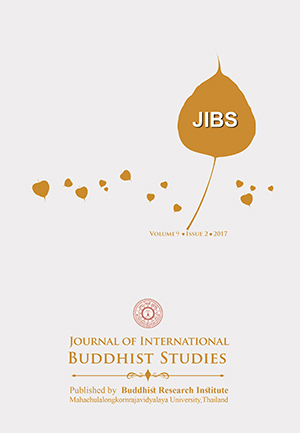Āsava As The Root Cause of Saṁsāra
Keywords:
Āsava, Saṁsāra, Transmigration, ĀsavakkhayaAbstract
Āsava is a key technical term in Buddhist doctrine that can be considered from the standpoint of psychology, metaphor, and philosophy. In the Buddhist perspective, Āsava is the root of saṁsāra (the cycle of birth and death) and therefore the cause of transmigration in saṁsāra. There are many discourses, Abhidhamma analyses, and commentaries in which āsava have been discussed in depth. In this paper, I elaborate on the definition of āsava, what the Buddha said in different discourses, the Abhidhamma analyses and the commentarial remarks on the āsava. To achieve this I look at its early classification, later development, and how āsava is the root cause of saṁsāra which brings beings to the transmigration and how one gets rid of āsava (Āsavakkhaya) and achieves the end of the cycle of birth and death.
References
Buddharakkhita,Acariya.(ed).Dhammapada: The Buddha’s Path of Wisdom. Buddha Dhamma Education Association Inc.
Bhikkhu, Nanamoli and Bhikkhu, Bodhi, (2009). MajjhimaNikaya: The Middle Discourse of the Buddha.Boston: Wisdom Publication. De Siva, Padmasiri. (1979).An Introduction to Buddhist Psychology. U.S.A:
Harper & Row Publishers Inc.
Malalsekera, G.P.(1996).Encyclopedia of Buddhism. Vol.2. Ceylon:
The Government Press.
Thera, Nyanaponika. (1991). Buddhist Dictionary: Manual of Buddhist terms
and Doctrines. Singapore: Singapore Buddhist Meditation center. Buswell, Robert E. & Lopez, Donald S. (2014).The Princeton Dictionary
of Buddhism. Princeton and Oxford: Princeton University Press. Gethin, R.M.L. (1992).The Mātikās: Memorization, Mindfulness, and List.In the Mirror of Memory (Reflections on Mindfulness and Remembrance in Indian & Tibetan Buddhism). Edited by Janet
Gyatso.149 – 172. New York: State University of New York. Maurice O’Connell Walshe (trans.). (2013). UpanisaaSutta: Upanisaa (SN 12.23).Retrieved January 26, 2018, from http://www.access
toinsight.org/tipitaka/sn/sn12/sn12.023x.wlsh.html > ThanissaroBhikkhu. (2013). NibbedhikaSutta: Penetrative”(AN 6.63).
x
tipitaka/an/an06/an06.063.than.html
ThanissaroBhikkhu (Trans.). (2013).VipallasaSutta: Perversions(AN 4.49).
Retrieved January 26, 2018 frohttp://www.accesstoinsight.org/
tipitaka/an/an04/an04.049.than.html
NyanaponikaThera. (2013). AnguttaraNikaya: The Discourse Collection
in Numerical Order. Retrieved January 26, 2018 from https://
www.accesstoinsight.org/lib/authors/nyanaponika/wheel238.html Āsavagocchaka of Dhammasaṇgaṇi.Retrieved January 26,2018
from https://suttacentral.net/pi/ds2.3.2
Avijjāsutta of Samyutta Nikāya(SN 45.1).Retrieved January 26, 2018 from
https://suttacentral.net/pi/sn45.1
Retrieved January 26, 2018 from http://www.accesstoinsight.org







